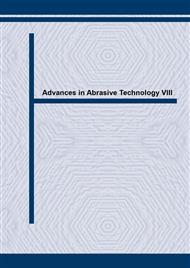p.3
p.9
p.15
p.21
p.27
p.33
p.39
p.45
p.51
Adaptive Table-Motion Control of a Surface Grinding Machine Using an AE Sensor
Abstract:
Improvement in grinding efficiency is very important to economically produce precision parts. This paper proposes a new table-motion control system for reducing non-machining time in the surface-grinding process and describes the results of performance tests of the system. The table-motion is adaptively controlled so that the table stroke is shifted along a workpiece shape. That is, an AE signal is emitted from the contact zone between a grinding wheel and a workpiece and is diminished when the wheel leaves the workpiece. When the signal level becomes less than a preset trigger level, a command is sent to a table controller to reverse the table-motion. By using the proposed system, unnecessary table over-travel is successfully eliminated and total machining time is reduced by 22 to 38 percent.
Info:
Periodical:
Pages:
9-14
Citation:
Online since:
August 2005
Authors:
Keywords:
Price:
Сopyright:
© 2005 Trans Tech Publications Ltd. All Rights Reserved
Share:
Citation:


